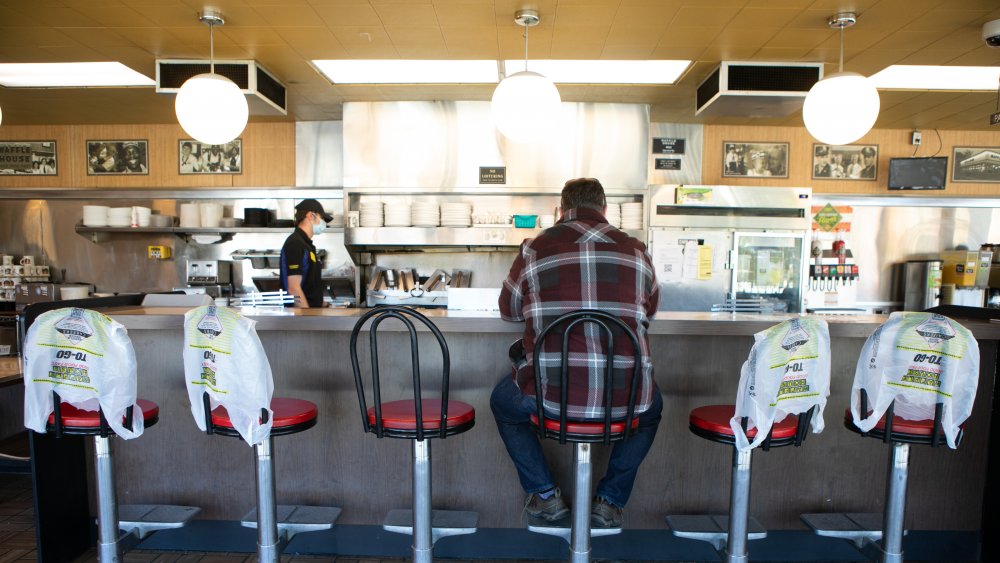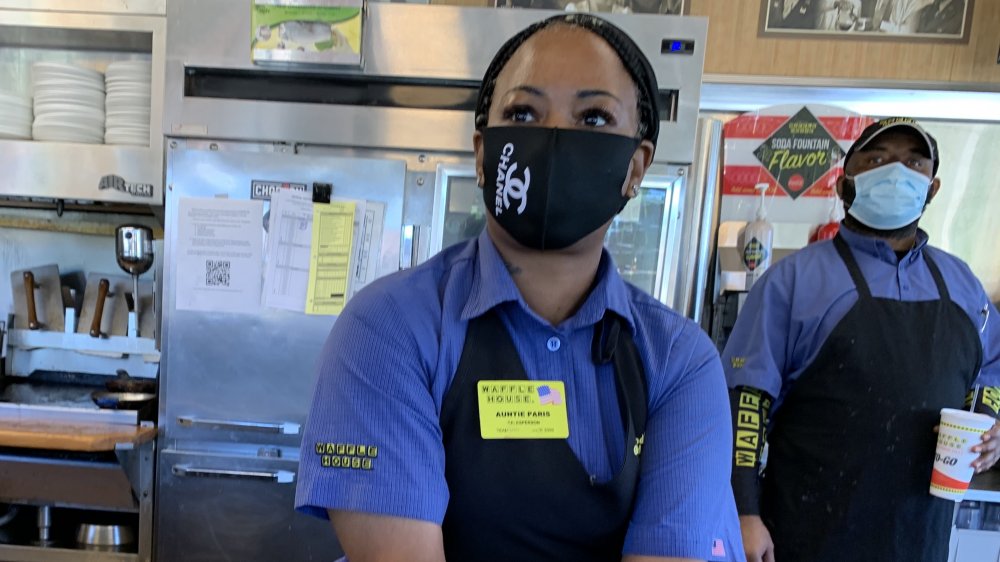Why Waffle House Employees Are So Unhappy Right Now
We can't think of any restaurant chain that is an institution amid a crisis the way Waffle House is. Its steadfast reliability, even in the face of dangerous natural disasters, from tornadoes to hurricanes, has made it the inspiration for the unofficial Waffle House Index, endorsed by FEMA, and which gauges the severity of natural disasters based on its operating status.
But even Waffle House blinked when faced with the COVID-19 pandemic. It ended up closing 700 restaurants — that's nearly half — of its 2000 locations across the country, while keeping the rest open for takeout and delivery (via Bloomberg). And as some states return to business as usual, members of its senior management say they're on track to making a full comeback.
Social distancing has hurt Waffle House's bottom line
"Our normal business was down about 70 percent. So we had about 30 percent of our revenues in the stores that were just doing to go. That number probably got down to about half this past week. So we're still at a reduced capacity to where we normally are. But it was a very orderly flow of some additional people into our restaurants. So we were very pleased ... with the return of the customers," the chain's CEO Walt Ehmer, who is a member of the White House group to restart the food and beverage industry, told Fox Business.
To cope with the shutdowns caused by the coronavirus, the chain had to cut hours for its workforce, furlough corporate staff, and slash pay among senior board members (their pay packets saw the biggest reductions). And while the White House considers Waffle House a model on how to reopen dining rooms in the midst of coronavirus (via WBSTV), some of its employees might beg to differ.
Waffle House employees had hours cut and saw their workloads increase
Eater says restaurant closures caused 28,000 hourly workers to lose their jobs at Waffle House. Those whose jobs were saved have had their hours cut by more than half; but their workloads more than doubled as a result, because in addition to serving, staff are now expected to keep restaurants as clean and germ-free as possible, on top of cooking, packing up food, and dealing with customers. And because there were no dine-in guests, there were little to no tips, which meant a reduced income overall. Even for a company used to operating in a crisis, the pandemic was a new normal for Waffle House. The restaurant is used to seeing clients rush through their doors after hurricanes, where one employee at a Waffle House in Florence, South Carolina, told Eater that she saw sales jump from the usual $1,000 to $2,000 to $5,000 during a post-hurricane shift.
Reduced hours has also meant reduced benefits for Waffle House
Reduced hours has also brought an end to benefits which might have been paid to workers who stay on for a certain number of hours per week, including vacation pay, maternity leave, and sick leave. A new policy says managers and hourly workers who have been diagnosed with the flu or COVID-19 "may be eligible to receive some paid leave benefits," but others who might have been exposed to the virus, could apply for unpaid personal leave (via Eater).
While Waffle House executives are raring for things to get back to normal, it's frontline staff aren't as keen. One employee tells Eater: "I don't think it is safe enough as of now. As a matter of fact, I think we should require masks to enter the restaurant." Another, who lost two relatives to COVID-19, said she was apprehensive about opening too soon, because there could be a second wave of illness if everything happens too quickly. They may not have a say, because Waffle House has already reopened at least 400 restaurants across Georgia and Tennessee. It remains to be seen whether management's apparent haste to revive business will actually benefit the company and its employees in the long run.



